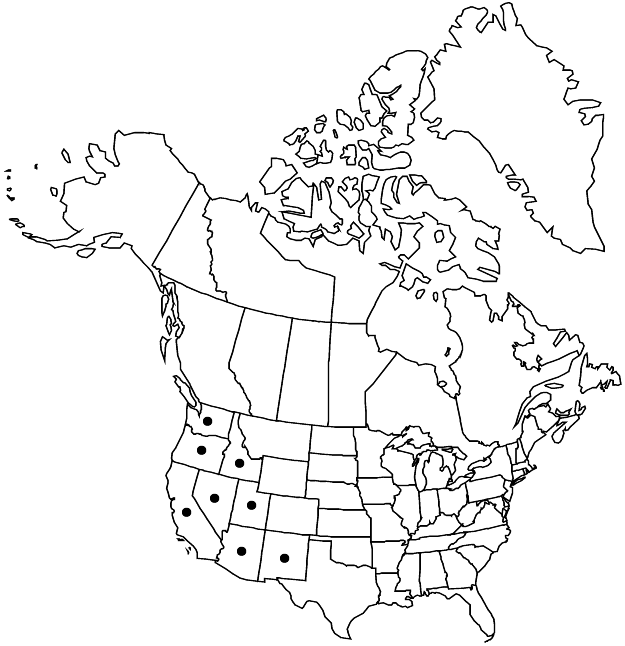Eriogonum maculatum
Muhlenbergia 2: 188. 1906.
Herbs, erect to spreading, annual, 1–2(–3) dm, tomentose, greenish to reddish. Stems: caudex absent; aerial flowering stems erect, not striated or angled, solid, not fistulose, 0.1–0.5 dm, tomentose. Leaves basal and cauline; basal: petiole 0.3–1 cm, floccose, blade lanceolate to obovate, 1–3(–4) × 1–1.5(–2) cm, tomentose abaxially, sparsely floccose to glabrate and grayish to greenish adaxially, margins entire or infrequently crenulate; cauline sessile, blade lanceolate to oblanceolate, 0.5–2 × 0.3–1 cm, similar to basal blade. Inflorescences cymose, open, 5–25 × 10–30 cm; branches tomentose; bracts 3, scalelike, 0.5–2.5 × 1–2 mm. Peduncles spreading, straight or nearly so, filiform, (0.5–)1–3 cm, glandular-puberulent. Involucres campanulate, 1–1.5(–2) × 1.5–3(–3.5) mm, glandular-puberulent; teeth 5, erect, 0.4–0.8 mm. Flowers 1–2.5 mm; perianth white to yellow, becoming pink or red, with a conspicuous rose-purple spot on each outer tepal, glandular-puberulent; tepals dimorphic, those of outer whorl elliptic to roundish or obovate, inflated from base to middle, those of inner whorl lanceolate; stamens included, 1–1.5(–2) mm; filaments pilose proximally. Achenes brown, 3-gonous, 1–1.5 mm, glabrous. 2n = 40.
Phenology: Flowering Apr–Nov.
Habitat: Sandy to gravelly or clayey flats and slopes, mixed grassland, saltbush, creosote bush, and sagebrush communities, pinyon-juniper and montane conifer woodlands
Elevation: 100-2500 m
Distribution

Ariz., Calif., Idaho, Nev., N.Mex., Oreg., Utah, Wash., Mexico (Baja California).
Discussion
Eriogonum maculatum is the most common and widespread expression of the E. angulosum complex, being found in Arizona, California, southwestern Idaho, Nevada, northwestern New Mexico, eastern Oregon, western Utah, and southeastern Washington. It is often common to abundant and may even be weedy, especially along roadsides intermixed with other annual wild buckwheats. The swollen bases of the outer tepals readily distinguish the species. The greatest concentrations of the spotted wild buckwheat are found in the Mojave Desert and the Great Basin. A specimen supposedly found on the “Laramie Plains” of Wyoming (Parry s.n., 1882, ISC) is discounted as to location.
Selected References
None.
